Abstract
To explore the effects of forest therapy in the Kranjska Gora tourist destination, experimental research on 50 tourists was implemented. By designing and following a specific forest therapy protocol, the physiological stress markers and psychological effects on tourists were measured. The results provide clear evidence of positive effects and health benefits on tourists. Additionally, the forest therapy experience is presented through the tourists’ fit-back and perception. The research results could be very useful for destination management, tourist providers, and the development of a forest therapy tourism activities, as well as the well-being forest tourism.
1. Introduction
The development of forest therapy (FT) was triggered by the need to relax in the forest and to isolate from various stressors. Professor Qing Li, of Department of Rehabilitation Medicine, Nippon Medical School Hospital, Japan, the world’s foremost expert in forest medicine and immunology, and Amos Clifford, the founder of the US-based Association of Nature and Forest Therapy, the world-leading organization in the movement to integrate nature and forest therapies, recognize FT as a method in which the natural environment of the forest is used for health care practices. There are many research studies about the positive physiological and psychological beneficial impacts and effects of the forest environment on human health and well-being so far [1,2,3,4,5,6], and several review articles on the same subject [7,8,9,10], but very little on tourists at a tourist destination.
The connection between forest bathing and the field of tourism was made by Konu (2015) in her definition of forest well-being tourism. Furthermore, the authors Ohe, Ikei, Song, and Miyazaki (2017) later defined forest therapy tourism (FTT) as an emerging tourism activity. With a relatively new tradition of maintaining personal health and well-being, the so-called ‘forest bath’ (or jap. shinrin-yoku), a type of forest relaxation theory, combined with recreation [1,11], and a touristic activity [12], a new type of tourist product could be created. An integration of tourism and health services could lead to the development of a forest therapy tourist product [13], and subsequently also to the quality development and institutionalization of forest tourism as a specific type of tourist activity [14,15]. FTT therefore has two aspects: it can be used for patients in support of therapy and for tourists in pursuit of wellness tourism.
Therapeutic forest activities that are already carried out in tourism practice, include naturopathic elements, such as water immersion (e.g., Kneipp therapy) and climatotherapy (climatic terrain cure, heliotherapy, and fresh-air rest cure) to enhance the health benefits of forest mindedness and nutritional therapy [7,15,16]. Some countries, among the first of which were Japan and China [17], as well as Sweden [18], carry out public health promotion in the forest in addition to forest tourism activities, while in Germany, FT is incorporated into the national health system [13]. In Poland, citizens stated that recreational activity in urban green spaces and forests reduced stress caused by the COVID-19 pandemic. On this basis, the Polish Tourist Organization is planning to examine the new travel habits of domestic tourists [19]. The forest has a therapeutic effect and relieves many symptoms of respiratory diseases, psychosomatic diseases, mental illnesses, cardiovascular diseases, lifestyle disorders, oncological diseases, neurological diseases, and certain orthopedic diseases, and it preventively strengthens human physical and mental health [20]. There is growing tourist use of socio-cultural forest values for therapeutic tourism purposes, and the connection between FT and tourism is evident [21].
Undoubtedly, there is an embracement of FT as a new healthy activity among different stakeholders within the tourism industry, where health is recognized as new wealth. To find out the healing effects of the Kranjska Gora destination forest area on tourists, the physiological stress markers [22] and psychological parameters were measured. Cortisol concentration, DHEA concentration, systolic blood pressure, diastolic blood pressure, and heart rate are commonly used parameters for the immune system and general human well-being [5,6,23]. SPANE is a commonly used scale for measuring human well-being [24,25]. The need for the Pemberton happiness index [26], a measure of well-being that integrates various aspects of an individual’s well-being, was recognized, beside the positive and negative emotions. The PHI is a general measure of human well-being that contains both hedonic and eudaimonic elements of well-being. Additionally, the PHI focuses on psychological factors that could influence the well-being assessment. Pemberton’s happiness index consists of two scales, one that assesses remembered well-being and includes the domains of general, hedonic, eudaimonic, and social well-being. The second scale experienced well-being, where positive and negative events that could be related to experiencing well-being are listed.
This research wants to enlighten not only the physiological and psychological therapeutic effects of the forest on tourists, but also the applicability of FT in the tourism industry
2. Materials and Methods
The research took place in the Kranjska Gora destination (see Figure 1), an Alpine valley with developed tourist infrastructure, which lies in the northwestern part of Slovenia, right next to the border with Austria and Italy.
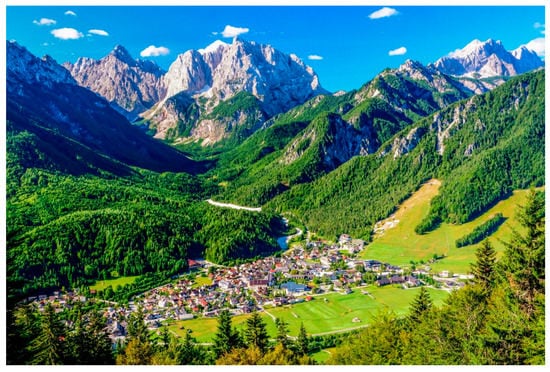
Figure 1.
Kranjska Gora valley.
The interdisciplinary team of specialists conducted this research. One of them was the specialist for forest tourism from the Vocational College for Hospitality, Wellness and Tourism Bled, Slovenija, the other was the fito-pharmacy specialist from the Faculty of Pharmacy, University of Ljubljana, and the third was the doctor specialist of internal and social medicine and ANFT certificated guide to FT (see Appendix A, Figure A1). Physiological measurements were examined and conducted by a certified laboratory and medical equipment, and validated by the Ministry of Health (see Appendix B, Figure A2). A clinically validated monitor device was used for blood pressure monitoring. All psychological tests (SPANE, PHI I, and PHI II) were validated by the Department of Psychology at The Faculty of Arts, University of Ljubljana.
2.1. Population Definition
The research recruited 50 male and female adult volunteers (hereinafter referred to as tourists) who were willing to spend forty-eight (48) hours at the destination of Kranjska Gora. One of the main definitions of a tourist that distinguishes a tourist from a day tripper or excursionist is an overnight stay of 24 h or more away from home (Jafari and Xiao, 1957). The recruitment of volunteers was made via a public call on the website of the Municipality of Kranjska Gora. The information was also shared on social media. Fifty volunteers were included in the study. On the day the survey began, 47 volunteers arrived at the site, and 3 dropped out due to possible COVID-19.
2.2. Forest Therapy Sessions
A few days before the tourists arrived, all four forest therapy (FT) guides met at the destination of Kranjska Gora and selected individual forest locations where they later guided the tourists through FT sessions. On the day the forest therapies (FT) were performed, the four FT guides met in the morning to check the details of the FT protocol once again, and they took time to connect with nature and with themselves in silence immediately before conducting the FT sessions. After that, each FT guide joined his group of tourists and provided a short introduction, a personal presentation, and a presentation regarding the destination of Kranjska Gora. Before the FT started, the tourists were invited to be extremely respectful of nature, to be careful while walking, and to manage their fluid intake and sun protection. This was followed by a short presentation about the basics of FT. The tourists were exposed to two conducted forest therapies in the forest. They walked, altogether, approximately 1 km during each of the two FT sessions on pre-selected forest paths. A guided structured walk, with an ANFT certified forest therapists (see Appendix A, Figure A1) was used as a method of exposure to the forest, as described below.
In the introductory circle, each tourist stated his name and described why he was grateful that day and identified his favourite creature from nature or favourite type of tree. This was followed by invitations in accordance with the standard FT sequence: pleasure of presence, what’s in motion, and tea. Between what’s in motion and tea, the forest therapy guides included two of the following invitations in the morning or afternoon: socializing with water, mirrors, time for yourself, and small things. Each volunteer, therefore, experienced all the invitations. The conduct of the “Pleasures of Presence” invitation: In a flat and open area, the guide asked tourists to form a circle and when ready to close their eyes (or keep them softly open). The guide invited them to focus on their senses, one at a time. He asked: “What scents do you perceive? What sounds can you hear far away? Which ones are closest to you? Can your skin feel the wind?” The guide then asked tourists to open their eyes very slowly and imagine they are seeing the world for the very first time.
The conduct of the “What’s in Motion” invitation: The guide invited the group to walk very slowly for approximately 10 to15 min and observe whatever is in motion (insects, leaves in the wind, etc). At the end of this invitation, the guide asked tourists to choose a “being” in the forest—such as a leaf or a rock—and pass it around the group. As each person held that being, they shared their experiences, while others practiced deep listening. At the end of the time designated for each invitation, the guides invited the tourists to form a circle to share their experiences. During the tea session, the guides offered the tourists sunflower and pumpkin seeds and dried cranberries and thanked them for taking part in the walk. Together, the guides and the tourists then thanked nature for revealing itself to them and returned a cup of tea to the earth for this purpose. Before that, each guide expressed his intention and/or what he wanted to give back to nature through his offering of tea. This concluded the FT session. Then, during a snack, the tourists chatted individually or in small groups and shared the messages they received from nature, and they headed toward their accommodations.
2.3. Research Protocol Design
In the following, we present the designed protocol, which was followed by all participants of the research.
- Step. Defining of the physiological and psychological parameters according to the purpose of the research.
- Step. Sample criterion. Two selected criterions were followed. The first was based mainly on the fact that participants have to define themselves as tourists, which is why the accommodation for all of them was arranged at the destination for two (2) nights. The second was based on the accommodation facilities capacity. Fifty beds were provided by the municipality and the tourist organizations in situ, so fifty (50) voluntarily registered adults of the male and female sex, who were willing to spend forty-eight (48) hours at the destination of Kranjska Gora, were planned by design.
- Step. To define the sampling method. An online announcement was chosen for the recruitment of volunteer participants on the website of the Municipality of Kranjska Gora, as well as through shared information on social networks. Fifty (50) volunteers were planned to be included in the study.
- Step. Inclusion criteria: volunteers in the age group 19 to 100, both sexes.
- Step. Exclusion criteria: persons unable to complete the questionnaire; persons unable to walk in the woods; persons who did not submit all the necessary samples before and after the therapies; persons who did not adhere to the deadlines in the implementation protocol and who submitted samples or completed questionnaires late or at different deadlines.
- Step. Research itinerary.
- Before arriving in Kranjska Gora, all registered tourists were informed by e-mail in detail about the course and purpose of the research. All the participants were invited to sign a voluntary statement of informed consent to participate in the survey.
- All registered tourists were asked to fulfill a psychological questionnaire online on Wednesday, 16 June 2021 in their usual environment, two days before arriving at destination at a specific time, between 8 and 9 am. They did the same the second time after both forest therapies at the Kranjska Gora destination. The participants were answered the questionnaire both times at the same time: between 8 and 9 am.
- Registered tourists were randomly divided into 4 groups according to ANFT protocol sample size criteria (12 or 13 participants in each group). Each group acted as a unit that was accommodated separately. Each participant was accommodated in a 4-star accommodation at the Kranjska Gora destination tourist providers. One of them, Jasna Chalet, is shown in Figure 2. Each group was provided with its own assistants to perform the measurements, and each group had its own forest therapist. The groups did not meet each other (except at a joint meeting).
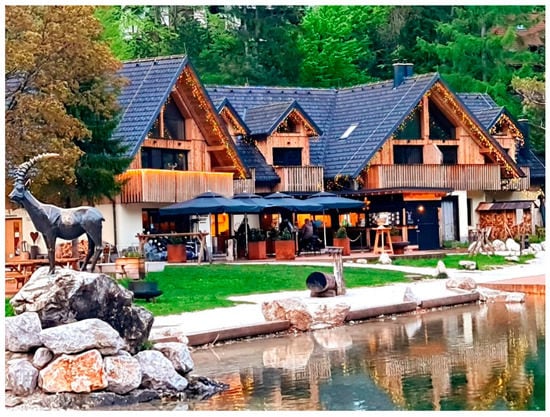 Figure 2. Jasna Chalet Resort by the lake Jasna, Slovenia: http://jasnaresort.com/en/ (accessed on 22 June 2022).
Figure 2. Jasna Chalet Resort by the lake Jasna, Slovenia: http://jasnaresort.com/en/ (accessed on 22 June 2022). - On Friday, 18 June 2021 (day 1), after arriving in Kranjska Gora, all registered participants were informed once again about the course and purpose of the research.
- On Saturday, 19 June 2021, after the first night sleeping in the destination, all participants became tourists. After breakfast, all tourists provided their first saliva samples in the morning to measure stress hormone concentrations (cortisol and DHEA), blood pressure (systolic and diastolic), and heart rate. Sampling tubes and sampling instructions were provided by the same laboratory mentioned above. The collection of a saliva samples prevailed over the collection of a blood samples, mainly to avoid possible inconveniences or stress from needle insertion, and because it is more user-friendly.
- On Saturday, 19 June 2021, during the day, tourists divided into 4 groups 2× (1× morning and 1× afternoon) and participated in FT. The first FT session lasted 3 h and was conducted between 10 am and 1 pm, and the second lasted for 2 h between 3 pm and 5 pm. Forest therapies were performed by ANFT-certified guides according to the protocol of the educational institution.
- On Sunday, 20 June 2021 (after the second night at the resort), all tourists participated in the survey in the morning between 8 and 9 am and took the same set of tests and measurements as on Saturday, at the same time as the previous day.
- They also filled in the psychological questionnaire again, which they filled in at home 2 days before arriving in Kranjska Gora. The time of completion of the questionnaire was defined between 8 and 9 o’clock in the morning.
- Saliva samples were agreed to be delivered on 21 June 2021 to the diagnostic laboratory, which performed the necessary physiological measurement results.
- All participants gave signed conscious and free consent to the research. All volunteers who decided to participate in the research were informed in an appropriate and understandable way about the purpose, plan, and methods of the research. They were also informed that they could withdraw their consent at any time without explanation. They were promised data protection as well. All voluntarily registered tourists registered in writing and undertook to comply with the PCT conditions in force at the time of the survey.
- Data collection and analysis. Each registered tourist was be registered by name and surname. At the suggestion of the loratory that performed the sample analysis, we abandoned the original idea of recording with computer-generated code. The proposal of the laboratory to perform the analysis is to state names and surnames, as in the case of an incorrect or duplicate code number, the sample and/or duplicate samples must be discarded. All data were to be used only to prepare a report on the results of the research and a research article, without providing personal data. The rest of the biological material was professionally (routinely) discarded and destroyed.
3. Results
In this study, a set of fifty (50) participants was reached. They all agreed to take acquired physiological and psychological measurements according to protocol. Additionally, they agreed to obtain the status of a tourist by accepting two nights of accommodation in the Kranjska Gora destination.
Of the 50 selected volunteers, 47 valid samples for physiological measurements were obtained. Due to the COVID-19 or non-submission of a saliva sample prior to therapy, three participants canceled their registration or did not completely fulfill the required physiological measurements. A total of 47 participants were present during all of the study process (Figure 3) and participated in two forest therapies, according to research protocol. In addition, each participant filled out two psychological questionnaires twice. Due to incomplete answers or unsubmitted questionnaires, 7 questionnaires were invalid and 43 valid questionnaires were obtained for further processing of the results.
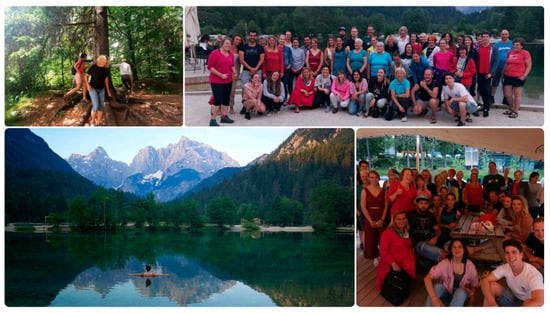
Figure 3.
Of the fifty volunteers, forty-seven arrived and accommodated in the Kranjska Gora destination forest area.
In accordance with the protocol, the measurement of following parameters was realised according to the study protocol design before and after the FT experience at the Kranjska Gora destination:
- stress-indicating hormone DHEA (dehydroepiandrosterone) with saliva sample;
- stress-indicating hormone cortisol with saliva sample (Figure 4);
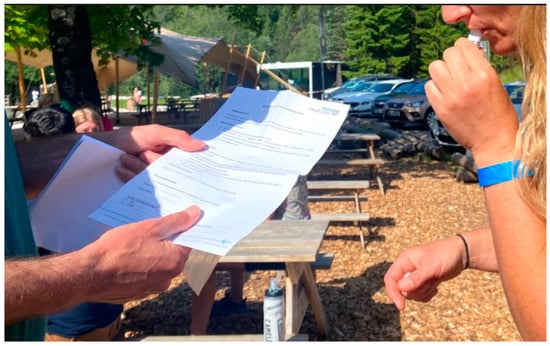 Figure 4. Taking the saliva sample of participant.
Figure 4. Taking the saliva sample of participant. - blood pressure (systolic and diastolic) (Figure 5);
 Figure 5. Blood pressure measurement with validated and clinically approved device.
Figure 5. Blood pressure measurement with validated and clinically approved device. - heart rate;
- stress index;
- the scale of positive and negative experience (SPANE);
- the Pemberton happiness index (PHI I and PHI II).
Physiological measurements were conducted according to instructions of Diafit, d.o.o., Spodnji Slemen 6, 2352 Selnica ob Dravi, Slovenia. The clinically validated monitor device Model M6AC (Omron Healthcare Co Ltd.: Muko-shi, Japan) (Model M6AC: OMRON M3: http://www.dableducational.org/Publications/2014/ESH-IP%202010%20Validation%20of%20Omron%20M6%20AC%20(HEM-7322-E).pdf (accessed on 18 August 2022)) was used for blood pressure monitoring. All psychological tests (SPANE, PHI I, and PHI II) were validated by the Department of Psychology at The Faculty of Arts, University of Ljubljana.
3.1. Stress Marker Parameters—Overall Average and by Gender
The mean values of most of the measured parameters (markers of stress) were higher in men than in women (see Table 1 and Table 2), with two exceptions out of ten (diastolic pressure before FT and heart rate after FT), which were higher in women. The largest difference was in the concentration of the hormone DHEA in saliva before FT, which was, on average, more than two times higher in men than in women. However, none of the gender differences were statistically significant.

Table 1.
Average concentrations of the two stress-indicating hormones cortisol and DHEA before and after forest therapy.

Table 2.
Average values of heart parameters (pressure and rate) before and after forest therapy.
Average concentrations of the two stress-indicating hormones cortisol and DHEA before and after FT are given in Table 1 below.
Average results of systolic and diastolic pressure, both before and after FT experience, are given in Table 2 below.
3.2. Comparison of Parameters before and after Forest Therapy
To compare the measured parameters before and after FT, the differences were calculated (Table 3). We can see that in the entire population after FT, all five stress markers decreased compared to their values before FT. Additionally, in the separate calculation for each gender, we see that in women, the results of all five measurements decreased, and in men, the results of four measurements decreased; only cortisol increased slightly (statistically insignificantly) from 8.16 to 8.47 nmol/L, which is 3.8% of the initial value. In women, cortisol decreased by 6.5%, which was also not significant.

Table 3.
Differences in average values of measurements of physiological parameters before and after forest therapy.
The hormone dehydroepiandrosterone (DHEA) decreased much more than cortisol during FT. It decreased by 26% in the general population, by 41% in men, and by 18% in women. Because men had high variability in this hormone, this decrease was not significant in men and the general population, but it was significant in women. The decrease in systolic pressure, diastolic pressure, and heart rate (pulse) was statistically significant both in the entire population and in a separate analysis of the female subpopulation. In men, due to greater variability, lower pressure reduction was not significant.
3.3. Stress Index
Stress is a human condition that is reflected in different individuals with slightly different changes in individual physiological parameters, and the measurements of physiological parameters are influenced by other factors and random error. As a result, the state of stress can be measured more accurately by calculating the stress index, where part of the random error and individual characteristics is reduced due to the larger number of measurements included in one parameter.
In this study, the stress index is calculated as the average of the normalized values of all five measured physiological parameters according to the following formula:
As normalization coefficients (nk, nD ns, nd, and np), we used the average normal values of each of the parameters as follows: ten (10) for cortisol, one thousand (1000) for DHEA, one hundred and twenty (120) for systolic pressure, eighty (80) for diastolic pressure, and seventy (70) for pulse. In this study, the stress index decreased during FT (Table 4) by more than 7% in the entire population. The decrease was 5% for women and 13% for men.

Table 4.
Average values of the stress index before and after forest therapy.
The decrease in the stress index was statistically significant both in the overall population and in a separate analysis of the female subpopulation. In men, due to greater variability or lower pressure reduction, the decrease in the stress index was not significant, although the decrease was higher than in women.
We observed that in volunteers who had a higher level of stress at the first measurement, the stress reduction during FT was higher. Therefore, we made an additional calculation from which we excluded 19 volunteers with a stress index at the first measurement of less than 85. In the remaining 28 volunteers with higher stress, the reduction in the stress index was as much as 11.7%. In the overall population, there was an improvement of 7%.
3.4. Psychological Tests—Results of Paired Positive and Negative Experience as well as Hedonic and Eudaimonic Elements of Well-Being Parameters
Psychological tests were taken two times. The first time at participants’ homes, and second time after two (2) conducted FT sessions (1× morning and 1× afternoon) at the Kranjska Gora destination forest area. The first FT session lasted 3 h and was conducted between 10 am and 1 pm (Figure 6), and the second lasted for 2 h between 3 pm and 5 pm the same day on pre-selected forest paths in the vicinity of the accommodation facilities. The groups did not meet each other during the research and forest therapies. Forest therapies were performed by ANFT-certified guides according to the protocol of the educational institution. We performed a non-parametric Wilcoxon two related samples test on analyzing psychological tests. This test is used as an alternative to the paired samples t-test, as data are not normally distributed (but the results are very similar to the Wilcoxon test). The characteristic rate used in the calculations is 5%.
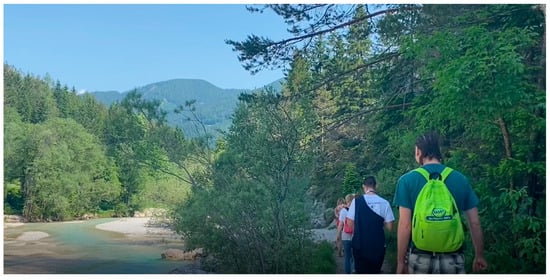
Figure 6.
Forest therapy sessions conducted by an ANFT-certificated guide.
The scale of positive and negative experience (SPANE) before and after the FT experience display of paired samples of positive and negative experiences is presented in Table 5. The recommended timeframe for a representative capture of emotions and experiences is four (4) weeks, which was not possible for two reasons: limited financial resources and the average length of stay, 2.5 days, which applies to the destination of Kranjska Gora and Slovenia. These facts lead us to the decision to offer and enable all participants two overnight stays in the destination of Kranjska Gora. We were interested in whether, when measuring the emotional states in the period between 16 June 2021, and 20 June 2021, despite a very short stay in the destination of Kranjska Gora, the emotional states of the participants improve significantly. The results in Table 5 show that individual positive emotions improved upward, while the impact of negative emotions decreased. Except for the stress parameter, the results for all other measured parameters show statistically significant positive results.

Table 5.
The scale of positive and negative experience (SPANE) before and after the forest therapy experience display of paired samples.
The results of the Pemberton happiness index PHI I and PHI II are given in Table 6 and Table 7. Pair 3: worth useful before—worth useful after (with 2-tailed sig. 0.006), pair 8: important before—important after (sig. 0.008), pair 10: bad moments before—bad moments after (sig. 0.744) and pair 11: potential before—potential after (sig. 0.054) did not show statistically better results, but all others, such as satisfaction, energy, worth usefulness, satisfaction with yourself, learning experiences, and enjoyment, did show statistically significant positive results.

Table 6.
Pemberton happiness index PHI I before and after the forest therapy experience—display of paired samples.

Table 7.
Pemberton happiness index PHI II before and after the forest therapy experience—display of paired samples.
The PHI II measurements dealt with perceived well-being (see Table 7). All measured parameters: overwhelmed, fun, enjoyed doing something, worried less, learned something interesting, things happened that made me really less angry, gave myself a treat, felt disrespected less, showed statistically significant positive results, except for the parameters proud before—proud after, bored before—bored after.
3.5. Forest Therapy Experience Is Presented through the Tourists’ Fit-Back and Perception
Usable questionnaire results (completed 80% of all 13 questions) were submitted by 31 tourists, 27 women, (73% of all female tourists involved) and 4 men (40% of all male tourists involved). A total of 66% of all 47 tourists participated in the survey. The highest share of tourists (36%) was from the 45–54 age group. Fifty-two percent of the tourists visit the forest several times per week, twenty-nine percent once per week, and thirteen percent every day. Forty-five percent of the tourists usually spend 1–2 h per week in the forest, twenty-three percent spend 2–4 h, nineteen percent spend 4–6 h and, the remaining thirteen percent spend 6 h or more in the forest.
When asked about the impact of socializing with the forest on the mind, the tourist respondents wrote some of the following: it relaxes me and distracts me from constantly planning and thinking about future work obligations; it relaxes me, calms me down, I feel good, reduces tension in the body; relaxing, anti-stress, improving concentration; socializing with the forest has an extremely relaxing effect on me, it inspires me, it helps me to clear my mind; disconnection of thought, reassuring; reassurance and clarity; positive, encouraging; the forest forms positive thoughts, walks through the forest have the effect of calming my mind; and easier concentration and focus. Among the answers to the question of how socializing with the forest affects their emotions, we find the following: pleasure, excitement; positive—I shake off any anger and bad mood; it has a relaxed, calming and positive effect; everything seems more relaxed to me, thoughts are calm; I am more loving to myself and to others, happy, joyful…; joy and love overwhelm me in the forest; soothing, meditative; it fills me with a sense of relaxation, happiness and joy; calms them, e.g., euphoric; and very different, sometimes triggering joy, sometimes crying, followed by relaxation, joy.
Most answers are about reduction in stress (calming, relaxing) and much less of the answers are about stimulation (excitement, euphoric) of the mood. This is in line with the expected effects of the FT, but can also be caused by the suggestive influence of the study. When the tourists listen to the birds while socializing with the forest, when they breathe the forest air and when they observe the natural environment, they reported feeling the following: I feel nature and all its power, tranquility, joy, happiness, constantly happening…; peace, contentment, happiness; release; peace and joy; coexistence with nature; helps to relax, drive away other thoughts; relaxation, joy of life, playfulness; energy, the power of nature; the power of good feeling and wonder; peace in oneself and joy; and lightness, calmness, curiosity…you could also say a kind of magic.
The scents the tourists perceive in the forest included the following: woody, the smell of earth, conifers; I usually go through the woods too fast and do not detect odors; depending on the period, the smell of spruce, mushrooms, cyclamen, earth; I would say that I do not perceive the smell so much, it is such a forest smell that I often perceive, but I really do not know what exactly emits this smell; in addition to the smell of the forest, it seems to me that I often smell mushrooms; fragrances, freshness, moisture-water; the smell of trees; moss, the smell of the morning, of the old house, of the wind and the shade; I sense the freshness of fresh air that clears my lungs, and I breathe deeply; and coniferous essential oils and flowering trees.
The tourists reported hearing the following sounds in the forest: birds singing, leaves rustling; singing of birds, rustling of leaves, movement of animals through the undergrowth, wind in the canopy; the sounds are cheerful and relaxing all the way from the chirping of birds and the rustling of leaves; crickets, birds, rustling of leaves, cracking of dry twigs underfoot; chirping, barking, breaking dry branches; the chirping of birds, the rustling of trees, the sound of animals; in the forest I hear the chirping of birds, the sounds of various insects, the noises of animals retreating before me, sometimes the barking of dogs from the village, the ringing of the clock in the bell tower of a nearby village; birds, rustling of canopies due to wind and undergrowth when walking; and the chirping of birds, the movement of branches, the rustling of leaves, the wind in the canopy.
The tourists’ attention in the forest was most often also attracted by the following: the green color of leaves, trees with their interesting shapes of leaves and bark, events in undergrowth and canopy; something special constantly happening, that is, from the movement and sounds of animals and plants; I am always fascinated by different shades of colors; I notice the most different shades of green and autumn colors; I am very attracted to winter in the forest; I admire the snow, the frost, the ice on the branches, and the footsteps of the animals in the snow; tall, mighty trees, the smell of the forest, the chirping of birds; wind and movement of plants, trees due to wind; it always seems to me as magical as if the forest spoke in this way; trees, canopy, leaves on the ground (especially in autumn), sometimes birds or clouds in the sky when I look at the canopy; and fluttering tree leaves; ants, mice, deer.
Many tourists expressed the admiration of the nature in their answers of their attention, sounds and scents in the forest. This could also have an influence on the relaxing effect of the FT.
The tourists wrote about the role of the FT guide as follows: The guide helped us to slow down, relax, do ordinary things in a different way and thus connect with ourselves, with nature, which opens the way to the process of self-knowledge and self-healing—to get the positive effects we need at a given moment; at the beginning it has an important role—it has this role to stop us and remind us of all the happenings in the forest, which we ourselves overlook or we completely forget that it is there, because we are always in a hurry or we are thinking about other things, instead of relaxing and connecting with the surroundings and experiencing it in its entirety; important—guiding, motivation, a kind of mentoring—and with invitations, it somehow gives ideas and teaches you in all the ways we can observe and explore the forest, connect with it; guides, helps and directs attention to the purpose of the chosen therapy to focus on the perception of either hearing, sight, smell; due to the different view, I did not know it was all so connected. In the end, I got the message of the ancestors with the help of a guide who led the group; a FT guide can play a very important role, especially for people who are not accustomed to such coexistence with the forest and who would like to get closer to it. The guide can also make people aware, show them how the forest can be healing for soul and body, and remind them that the forest is our home—so we need to take care of it; the guide is the connecting thread with the forest; guidance in returning to ourselves and in the awareness that we are part of nature; it has a connecting and motivating role, it helps people to open up; connecting an individual or groups with nature and vice versa. All the tourists reported that the forest environment calms them, helps them to focus, and fills them with joy and connects them with themselves.
4. Discussion
Based on the findings of the literature review, especially regarding the design of the research protocol recommendations and limitations [14] (p. 31,38), we devoted special attention to the protocol design. However, due to limitations in the conducted research, positive findings are disputable.
First and above all, it is difficult to isolate the impact of accommodation at the destination from the impact of the forest environment on the tourist.
Secondly, it is very expensive to assure a big enough research sample with the same protocol design; for example, for more than 500 participants, i.e., tourists. Nevertheless, we can say that by measuring the impact of the forest on the tourist between two nights, i.e., after the first night of sleep and finishing one day before departure, the study minimized the disturbance factors due to adaptation to the new environment.
The third limitation, in particular, is the scale time measurement and exposure time to forest environment. SPANE, PHI I, and PHI II are based on the measurement of the frequency of feelings during the past few weeks or one month. In the tourism industry, it is difficult to find a tourist who would spend so much time in a destination at once. However, such a measurement would not be in accordance with the real accommodation in situ.
Fourth, it is very difficult to provide a real destination environment for research purposes longer than we did in our research. It is also very expensive, due to the high season on the one hand and the real average occupancy of accommodation capacities at the destination (2.5 days) on the other. The scale is appropriately stable only over a 2-month period [27]; meanwhile, in it could be sensitive to fluctuations in mood if we are conducting a short-term measurement, such as in 2 days. The suggestions received from the experts from the University of Ljubljana, Department of Psychology recommended an observation period of 4 weeks for measurements, but one cannot afford this in tourism, and the question of the usefulness of a longer period of accommodation also arises as the average length of stay of a tourist at a destination is less than 3 days. That is why we decided to accommodate tourists for two nights at the destination, as the average length of tourist accommodation in the destination of Slovenia was 2.1 days [31]. Compared to other studies, the time of exposure to the forest in some cases was very short, barely 15 min [25]. Therefore, to achieve greater relevance of the results, we recommend repeating the same measurements in all seasons (spring, summer, autumn, and winter) with a longer period of accommodation for the participants as tourists at the destination, if possible.
Fifth, a controlled study should be carried out on tourist participants in a resort outside the forest area, with the same parameters.
Regarding the other parameters of the survey, we also note certain differences. Research studies were conducted during different seasons, for example in winter (ibid). Different techniques were used, such as Shinrnin-yoku [28], or recreation, such as walking or cycling [19,29]. The exposures to the natural environment were on different green areas, for example, in the forests, in city parks, at the coastal area, and elsewhere in nature [30].
Even though the tourists spent only 2 nights at the destination (which is the average period of tourist accommodation in Slovenia) [31], and the entire experience of FT was in one day, the results are very encouraging. The study measured the most frequently observed physiological and psychological parameters. The results of the measurements show that the signs of stress were greatly reduced in the period from Saturday morning to Sunday morning. The average values of all five measured physiological parameters were reduced after the two FT sessions: cortisol concentration in saliva, DHEA concentration in saliva, systolic blood pressure, diastolic blood pressure, and heart rate. The reduction in systolic blood pressure in our study was 3.8 mmHg, which is significant (p = 0.004), but slightly less than in a study on 12 volunteers in Hungary [22], where the reduction in systolic blood pressure was 6 mmHg. They did not measure cortisol, DHEA, diastolic blood pressure, and heart rate. In our study we observed a nonsignificant reduction in cortisol concentration in saliva (8 nmol/L before the forest therapies and 7.66 nmol/L after the forest therapies, p > 0.05), which is different than in the study on 17 volunteers in Japan [6], where the reduction was from 4.5 nmol/L to 3.3 nmol/L. According to our knowledge, we were the first to measure the influence of FT on a stress marker DHEA, and we found a significant reduction in this parameter in women and a strong nonsignificant trend of reduction in men. This reduction is most likely mainly due to the impact of the two FT sessions carried out on Saturday during the day. To minimize the influence of other factors, both measurements (before and after therapy) were performed at the same time of day (at 9 am). Since changing variables, such as the environment and vacation, are among the most stressful events [22], (p. 103); [32], (p. 28), the tourists in this study arrived at the Kranjska Gora location one day before the first measurement (Friday afternoon), so we expect a change in factors, such as location, accommodation, and type of breakfast, affected both measurements, but not the difference that occurred between Saturday and Sunday. It is still possible that the signs of stress from Saturday to Sunday were reduced due to factors other than FT. A study with two-day-conducted FT in Taiwan also notes that some factors that were not considered in the research, such as temperature, humidity, negative air ions, and illumination should be controlled in future studies in order to give a more precise estimation regarding the effects of visiting a forest [28]. Other possible factors are the forest climate, the ambience, carefree socialization, the comfort of the accommodations at the destination and the cuisine, and changes in the environment, which could also have a positive effect on the mental well-being of the tested tourists.
On the other hand, it is possible that FT had a beneficial effect on other physiological parameters that were not measured in the study, or that the impact of FT on the measured parameters may become more pronounced after a longer time.
The most used scale for assessing favorable and unfavorable emotions after exposure to forest is the positive and negative affect scale (PANAS) [27], or the profile of mood states (POMS) [25,30,31] scale. However, according to Diener (2009), it has some limitations, which made us decide to use the recommended scale of positive and negative experiences (SPANE). The SPANE was used for the measurement of the subjective feelings of well- and ill-being [23,24]. A different approach to measurement, however, the Pemberton happiness index (PHI I and PHI II) [21] of well-being, focuses on “experienced well-being,” which assesses people’s current emotional states and feelings in real time, rather than relying on individuals’ recall of feelings from past events/experiences. In addition to the POMS, other studies also used other questionnaires to measure psychological states, such as the restorative outcome scale (ROS), subjective vitality scale (SVS), Warwick–Edinburgh mental well-being scale (WEMWBS) [33], psychological well-being scale (WB) [34], or restorative outcome scale (ROS), and subjective vitality scale (SVS) [3]. Regardless of the type of psychological questionnaire, the outcomes are questionable due to too short exposure to the forest.
Found that, when evaluating well-being, it is more than the intensity of the emotion or emotional state, important duration, i.e., how long a certain positive or negative experience is. In addition, intensity is a more subjective concept, and the interpretation of intensity can vary considerably from individual to individual [24]. Pemberton’s happiness index, on the other hand, consists of two scales, one that is used to assess remembered well-being and includes the domains of general, hedonic, eudaimonic, and social well-being, and the second scale, experienced well-being, where positive and negative events that could be related to experiencing well-being are listed. We interpret the results of both tests.
Numerous studies and systematic reviews found and published many various health and well-being effects and benefits from FT as a specific type of exposure to nature [1,2,3,4,5,6,7,8,9,10,11,12,13,14,15,35]. At the same time, they indicate a lack of high-quality studies with clear scientific evidence, for example on the immune system, endocrine system, nervous system, etc. FT undoubtedly benefits human health, but it is not yet completely clearly proven what this therapeutic or healing effect is on individual disease indicators.
An observation period of 4 weeks would be desirable, but one cannot afford this in the scope of tourism. A longer regular practice of FT can be achieved in the home environment.
5. Conclusions
This study examined physiological and psychological therapeutic effects of the FT on tourists in the Kranjska Gora destination. The intention was to enlighten the usefulness of FT in natural tourist resorts and destinations. Forest therapies were conducted with the expert guidance of groups in accordance with the ANFT-specified and structured animation. Participants were placed in a real environment at the Kranjska Gora destination for two nights, so they became tourists. Testing the beneficial effect of FT in a real economic environment, it is necessary to provide quality user experiences. According to Zahng and Ye (2022, 13) “…it is necessary to enrich FT service products and to integrate forest therapies with tourism and health services and to consider leisure and tourism as a potential way of developing and implementing FT”.
Research protocol design was followed and realized by presented tourists at the research forest destination. The research was conducted from 18 to 20 June 2021. It provided the clear scientific evidence of the health benefits for tourists, resulting from the influence of the specific six (6)-step forest therapy tourism protocol at the destination of Kranjska Gora, Slovenia.
The results of this research will contribute to the body of knowledge about FT and will trigger innovative sustainable development solutions in the field of nontraditional tourist use of forests. With the new scientific findings in the field of public health, the clarification of FT human health benefits is also going to affect the development of forest therapeutic tourism. Further research activities should be conducted by the tourism sector regarding new markets and tourist segments based on this scientific evidence. This research will also contribute to the popularization of FTT in Slovenia and encourage decision-makers and stakeholders in the tourism sector to develop and expand the range of vigilant activities, including FT, in local natural environments within destinations such as Kranjska Gora who will recognize the potential of therapeutic forest tourism and the desire for a new and innovative development direction. In this way, they will also make an important contribution to the public health of the individual and society, and to the sustainable use of natural resources. The presented forest therapy tourism research protocol at the destination of Kranjska Gora can be used as guidance by planners and practitioners from all over to increase and improve the effectiveness of nature-based interventions within forest environments. By orienting towards the development of FT and well-being tourism, Slovenia could achieve extreme advantages in comparison with other green outdoor destinations.
Author Contributions
Conceptualization, D.C. and S.K.; methodology, D.C.; software, D.C.; validation, D.C., C.A. and S.K.; formal analysis, D.C. and S.K.; investigation, D.C., C.A. and S.K.; resources, D.C.; data curation, D.C.; writing—original draft preparation, D.C. and S.K.; writing—review and editing, D.C.; visualization, D.C.; supervision, D.C.; project administration, D.C.; funding acquisition, D.C. All authors have read and agreed to the published version of the manuscript.
Funding
This study was funded by the municipality of Kranjska Gora from Slovenia, an excellent, lively mountain village, the organizer of the FIS World Cup matches, located in the valley between the Julian Alps and Karavanke.
Data Availability Statement
Not applicable.
Acknowledgments
We are also grateful for the cooperation of all tourist organizations from the municipality that collaboratively support FTT development. We would like to thank for all their technical and administrative support, also.
Conflicts of Interest
The authors declare no conflict of interest. The funders had no role in the design of the study; in the collection, analyses, or interpretation of data; in the writing of the manuscript; or in the decision to publish the results.
Appendix A
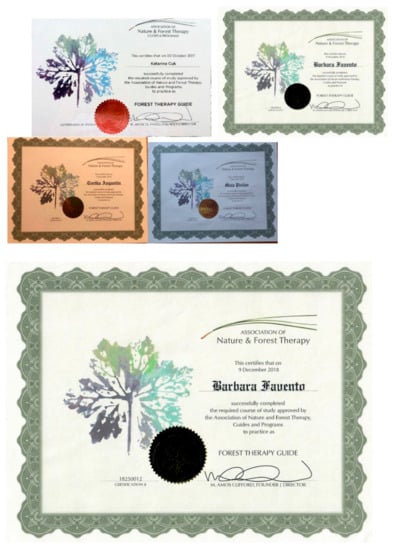
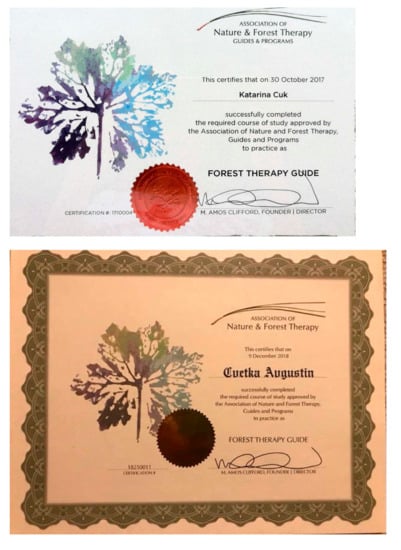
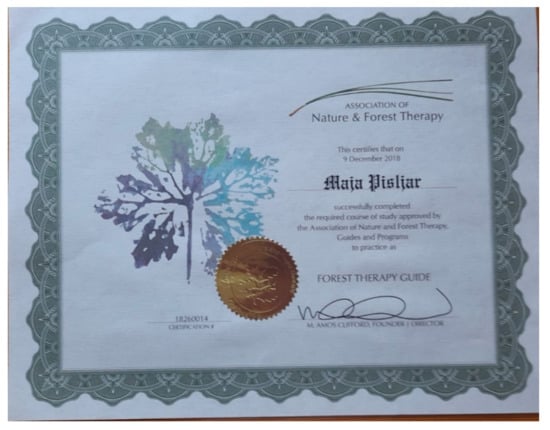
Figure A1.
The Association of Nature and Forest Therapy (ANFT)—4 Certificate for Forest Therapy guides, participating in this research.
Appendix B
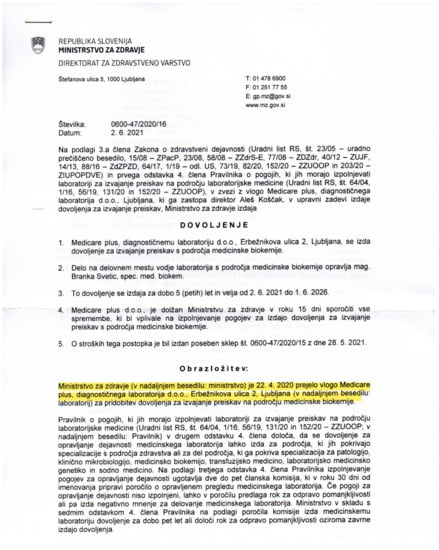
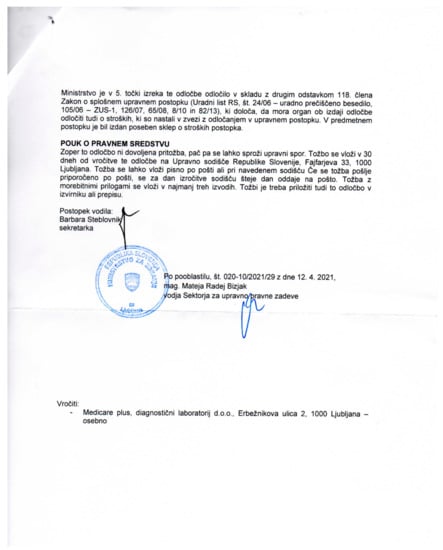
Figure A2.
Permission to conduct research in the field of biochemistry from the Ministry of Health.
References
- Li, Q. Effect of forest bathing trips on human immune function. Environ. Health Prev. Med. 2010, 15, 9–17. [Google Scholar] [CrossRef] [PubMed]
- Li, Q.; Kobayashi, M.; Wakayama, Y.; Inagaki, H.; Katsumata, M.; Hirata, Y.; Shimizu, T.; Kawada, T.; Park, B.J.; Ohira, T.; et al. Effect of phytoncide from trees on human natural killer cell function. Int. J. Immunopathol. Pharmacol. 2009, 22, 951–959. [Google Scholar] [CrossRef]
- Bielinis, E.; Łukowski, A.; Omelan, A.; Boiko, S.; Takayama, N.; Grebner, D.L. The Effect of Recreation in a Snow-Covered Forest Environment on the Psychological Wellbeing of Young Adults: Randomized Controlled Study. Forests 2019, 10, 827. [Google Scholar] [CrossRef]
- Jung, W.H.; Woo, J.M.; Ryu, J.S. Effect of a Forest Therapy Program and the Forest Environment on Female Workers’ Stress. Urban For. Urban Green 2015, 14, 274–281. [Google Scholar] [CrossRef]
- Ochiai, H.; Ikei, H.; Song, C.; Kobayashi, M.; Miura, T.; Kagawa, T.; Li, Q.; Kumeda, S.; Imai, M.; Miyazaki, Y. Physiological and psychological effects of a forest therapy program on middle-aged females. Int. J. Environ. Res. Public Health 2015, 12, 15222–15232. [Google Scholar] [CrossRef]
- Ochiai, H.; Ikei, H.; Song, C.; Kobayashi, M.; Takamatsu, A.; Miura, T.; Kagawa, T.; Li, Q.; Kumeda, S.; Imai, M.; et al. Physiological and psychological effects of forest therapy on middle-aged males with high blood pressure. Int. J. Environ. Res. Public Health 2015, 12, 2532–2542. [Google Scholar] [CrossRef]
- Stier-Jarmer, M.; Throner, V.; Kirschneck, M.; Immich, G.; Frisch, D.; Schuh, A. The psychological and physical effects of forests on human health: A systematic review of systematic reviews and meta-analyses. Int. J. Environ. Res. Public Health 2021, 18, 1770. [Google Scholar] [CrossRef]
- Hansen, M.M.; Jones, R.; Tocchini, K. Shinrinyoku (forest bathing) and nature therapy: A state-of-the-art review. Int. J. Environ. Res. Public Health 2017, 14, 851. [Google Scholar] [CrossRef]
- Doimo, I.; Masiero, M.; Gatto, P. Forest and well-being: Bridging medical and forest research for effective forest-based initiatives. Forests 2020, 11, 791. [Google Scholar] [CrossRef]
- Grilli, G.; Sacchelli, S. Health benefits derived from forest: A review. Int. J. Environ. Res. Public Health 2020, 17, 6125. [Google Scholar] [CrossRef]
- Konu, H. Developing a forest-based wellbeing tourism product together with customers–An ethnographic approach. Tour. Manag. 2015, 49, 1–16. [Google Scholar] [CrossRef]
- Ohe, Y.; Ikei, H.; Song, C.; Miyazaki, Y. Evaluating the relaxation effects of emerging forest-therapy tourism: A multidisciplinary approach. Tour. Manag. 2017, 62, 322–334. [Google Scholar] [CrossRef]
- Cvikl, D. Forest well-being tourist product: The case of shinrin-yoku, Obedska bara, Srbija. Tur. Posl. 2016, 18, 99–107. [Google Scholar] [CrossRef]
- Cvikl, D. Forest Therapy and Well-Being Tourism Literature Review–With Assessment of Potential for Slovenia. Acad. Tur. 2022. [CrossRef]
- Cvikl, D. Factors of Forest Tourist Attractivness. Ph.D. Thesis, University of Primorska, Koper, Slovenia, 2022. [Google Scholar]
- Chen, B.; Nakama, Y. Thirty years of forest tourism in China. J. For. Res. 2013, 18, 285–292. [Google Scholar] [CrossRef]
- Nilsson, K.; Sangster, M.; Gallis, C.; Hartig, T.; De Vries, S.; Seeland, K.; Schipperijn, J. Forests, Trees and Human Health; Springer Science & Business Media: Berlin/Heidelberg, Germany, 2011. [Google Scholar] [CrossRef]
- Schuh, A.; Immich, G. Waldtherapie: Das Potenzial des Waldes für Ihre Gesundheit; Springer: Berlin/Heidelberg, Germany, 2019. [Google Scholar]
- Looker, T.; Gregson, O. Premagajmo Stres: Kaj Lahko z Razumom Storimo Proti Stresu; Cankarjeva založba: Ljubljana, Slovenia, 1994. [Google Scholar]
- Šmejc, P. Individualno Upravljanje Stresa. Ph.D. Thesis, University of Primorska, Koper, Slovenia, 2011. [Google Scholar]
- Hervás, G.; Vázquez, C. Construction and validation of a measure of integrative well-being in seven languages: The Pemberton Happiness Index. Health Qual. Life Outcomes 2013, 11, 66. [Google Scholar] [CrossRef]
- Peterfalvi, A.; Meggyes, M.; Makszin, L.; Farkas, N.; Miko, E.; Miseta, A.; Szereday, L. Forest bathing always makes sense: Blood pressure-lowering and immune system-balancing effects in late spring and winter in Central Europe. Int. J. Environ. Res. Public Health 2021, 18, 2067. [Google Scholar] [CrossRef]
- Diener, E.; Wirtz, D.; Biswas-Diener, R.; Tov, W.; Kim-Prieto, C.; Choi, D.W.; Oishi, S. New measures of well-being. In Assessing Well-Being; Springer: Dordrecht, Switzerland, 2009; pp. 247–266. [Google Scholar] [CrossRef]
- Jovanović, V. Beyond the PANAS: Incremental validity od the Scale of Positive and Negative Experience (SPANE) in relation to well-being. Pers. Individ. Differ. 2015, 86, 487–491. [Google Scholar] [CrossRef]
- Grabowska-Chenczke, O.; Wajchman-Świtalska, S.; Woźniak, M. Psychological Well-Being and Nature Relatedness. Forests 2022, 13, 1048. [Google Scholar] [CrossRef]
- Venter, Z.S.; Barton, D.N.; Gundersen, V.; Figari, H.; Nowell, M. Urban nature in a time of crisis: Recreational use of green space increases during the COVID-19 outbreak in Oslo, Norway. Environ. Res. Lett. 2020, 15, 104075. [Google Scholar] [CrossRef]
- Wajchman-Świtalska, S.; Grabowska-Chenczke, O.; Woźniak, M.; Bałaj, B. Psychosocial Determinants of Recreational Activity within Urban Green Spaces during the COVID-19 Pandemic in Poland. Forests 2022, 13, 1569. [Google Scholar] [CrossRef]
- Chen, H.T.; Yu, C.P.; Lee, H.Y. The effects of forest bathing on stress recovery: Evidence from middle-aged females of Taiwan. Forests 2018, 9, 403. [Google Scholar] [CrossRef]
- Liu, Q.; Wang, X.; Liu, J.; An, C.; Liu, Y.; Fan, X.; Hu, Y. Physiological and Psychological Effects of Nature Experiences in Different Forests on Young People. Forests 2021, 12, 1391. [Google Scholar] [CrossRef]
- Annual Report of Slovenian Tourist Board for 2019. Available online: https://www.slovenia.info/uploads/dokumenti/tvs/2019/turizem_v_stevilkah_2019.pdf (accessed on 18 August 2022).
- Oh, B.; Lee, K.J.; Zaslawski, C.; Yeung, A.; Rosenthal, D.; Larkey, L.; Back, M. Health and well-being benefits of spending time in forests: Systematic review. Environ. Health Prev. Med. 2017, 22, 1–11. [Google Scholar] [CrossRef]
- Shin, W.S.; Shin, C.S.; Yeoun, P.S.; Kim, J.J. The influence of interaction with forest on cognitive function. Scand. J. For. Res. 2011, 26, 595–598. [Google Scholar] [CrossRef]
- Watson, D.; Clark, L.A.; Tellegen, A. Development and validation of brief measures of positive and negative affect: The PANAS scales. J. Personal. Soc. Psychol. 1988, 54, 1063. [Google Scholar] [CrossRef]
- Kotte, D.; Li, Q.; Shin, W.S.; Michalsen, A. (Eds.) International Handbook of Forest Therapy; Cambridge Scholars Publishing: Newcastle upon Tyne, UK, 2019. [Google Scholar]
- Zhang, Z.; Ye, B. Forest Therapy in Germany, Japan, and China: Proposal, Development Status, and Future Prospects. Forests 2022, 13, 1289. [Google Scholar] [CrossRef]
Publisher’s Note: MDPI stays neutral with regard to jurisdictional claims in published maps and institutional affiliations. |
© 2022 by the authors. Licensee MDPI, Basel, Switzerland. This article is an open access article distributed under the terms and conditions of the Creative Commons Attribution (CC BY) license (https://creativecommons.org/licenses/by/4.0/).